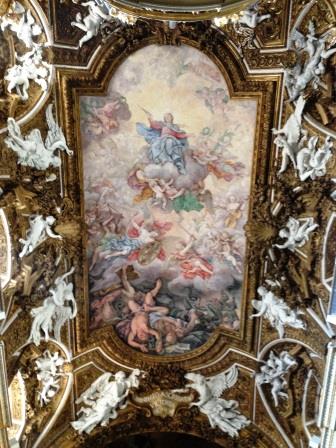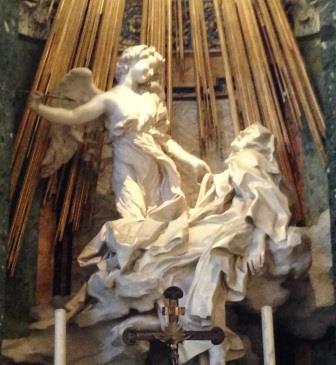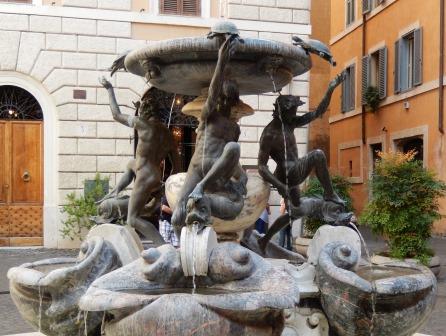Landed in Rome yesterday. In about 36 hours, we’ve shuttled through the history, religion, and politics of the last 2,500 years several times, even with a long nap time to shake off the jetlag. We’ve already hit 8 churches, the Colosseum, the Forum, and the National Museum. What a great place!

I’m on a Bernini Quest this time. So, yesterday afternoon, we waited out the long lunchtime schedule, (why does a church need 3 and a half hours for lunch?), to see Bernini’s famous St. Theresa in Santa Maria della Vittoria. Like many Italian churches, it has a stunning Baroque interior masked behind a drab, brick exterior. You have no idea what you are in for when you walk through the door. The ceiling, “Mary triumphing over Heresy”, by an artist you have never heard of, is heroic, especially because of the white angels hanging out of the plaster.
The whole church interior is a statement of visual splendor. The altar is backed by a gold spiritual explosion of radiance designed to arrest attention and to let the common man and woman know that important things happen in this space. The apse vault is another mammoth painting all framed in gold and richly colored marbles. As the church is relatively shallow, the effect of the magnificence is immediate and emphatic. That this is just another neighborhood church in the hometown of Catholicism is a statement of the wealth that was available to the church throughout the city.

Then, in the back-left chapel, (the one everyone is looking at), is Bernini’s masterpiece. St. Theresa was extremely influential in early Roman Catholic teachings because she wrote a book about her revelations and her strong faith. It was a best seller in her time, mainly because the church distributed copies. She joined the group of faith leaders of the early church along with St. Augustine because their testaments were written. That made her a star.
Bernini has taken her description of the moment of her divine inspiration to create an unforgettable work of art, not just of Theresa and her angel, but of the integrated theater of the entire chapel. When you look at this assemblage, it is very hard to believe that it has been carved from solid rock. The man cut stone as if it were butter. The scene is framed by recognizable church cardinals who become witnesses to this significant event. In real life they became the teachers who brought its meaning to their congregations.

Bernini spent most of his career creating astonishing delicacy from stark marble for his Roman Catholic patrons. However, he also admired the tiny Jewish community of Rome and “edited” one of the statues in their ghetto to include turtles. His thought was that turtles, like the Jewish diaspora, were obliged to carry their belongings on their backs. This is a pretty interesting ecumenical statement for a man many felt was a company man for Christianity.
We will see more Bernini on the trip, particularly at the Galleria Borghese on Friday. However, we did pay our respects at his resting place in the monumental Vatican church of Santa Maria Maggiore. His family mausoleum is in the floor, just to the right of the altar. Great placement, very modest statement, for a giant among Rome’s artistic elite.







